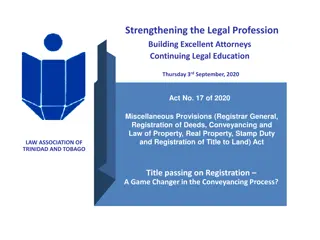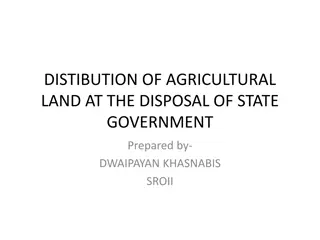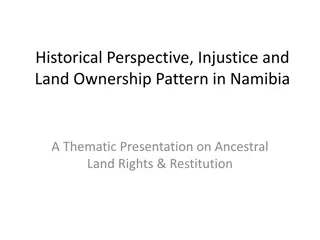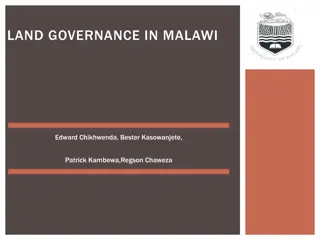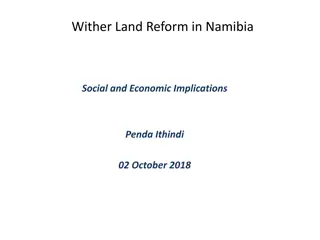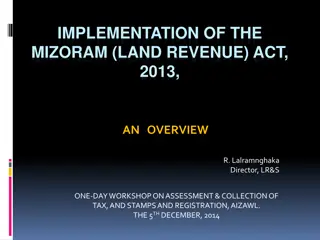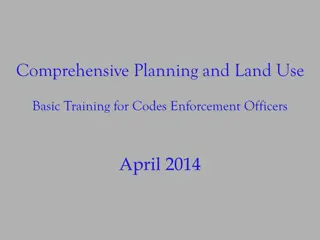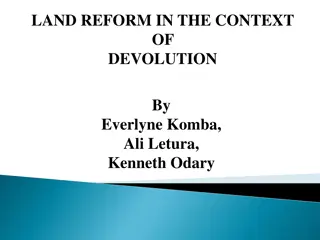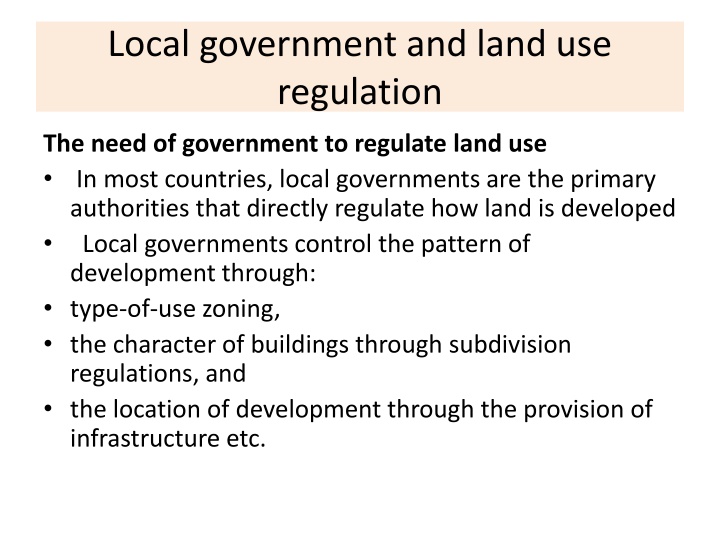
Local Government Role in Land Use Regulation
Explore the importance of government regulation in land use planning, market failures, and examples of externalities affecting urban land use. Learn how local governments regulate development through zoning, subdivision regulations, and infrastructure provision to prevent market failures and promote efficient resource allocation.
Uploaded on | 1 Views
Download Presentation

Please find below an Image/Link to download the presentation.
The content on the website is provided AS IS for your information and personal use only. It may not be sold, licensed, or shared on other websites without obtaining consent from the author. If you encounter any issues during the download, it is possible that the publisher has removed the file from their server.
You are allowed to download the files provided on this website for personal or commercial use, subject to the condition that they are used lawfully. All files are the property of their respective owners.
The content on the website is provided AS IS for your information and personal use only. It may not be sold, licensed, or shared on other websites without obtaining consent from the author.
E N D
Presentation Transcript
Local government and land use regulation The need of government to regulate land use In most countries, local governments are the primary authorities that directly regulate how land is developed Local governments control the pattern of development through: type-of-use zoning, the character of buildings through subdivision regulations, and the location of development through the provision of infrastructure etc.
Government regulation and market failure A market succeeds when it brings together a willing buyer and willing seller to make a mutually beneficial transaction in a way that satisfies the parties involved. However, there are certain well-recognized conditions under which market failure occurs. A market failure occurs when the market forces of supply and demand do not lead to the output society desires
Cont Markets do not allocate resources efficiently if: (1) property rights are not clearly defined or enforced; (2) Externalities affecting large numbers of people are associated with the production or consumption of a product; or (3) markets are not competitive.
Cont Examples of Market Failures Externalities: are situations in which a market transaction affects a third party who is not part of the transaction. A classic example is pollution, where people who do not purchase the good whose production created nevertheless face polluted air or water. the pollution must
Cont.. Another major form of urban land use externalities is congestion Congestion occurs when an individual uses a system (such as roads) near capacity and slows the performance of the entire system for all users. The resulting concentration of traffic imposes social costs on the non- car users
Cont A public good: is a good where it is difficult to charge people for using it, and where one person's use of the good does not diminish the good for others. The government provides goods and services such as military protection, street lights, and police protection. These goods and services may not be provided by the private sector because it would not be profitable for them to do so when non payers might enjoy the benefits
Cont Government can provide goods and services when it is difficult to exclude non-payers and when the product or service involves shared or non-rival consumption. government can require all citizens to pay for their share so no one gets a free good or service. For example, everyone desires police protection. However, because it is difficult to exclude people from the benefits of police protection, government supplies the service to everyone, and everyone pays for it through taxation Through taxation,
Cont Monopoly : is a market structure in which there is only one large firm that produces a product for which substitutes. Monopolies misallocate overpricing goods and services at the expense of some, and producing less output than is efficient from society s view as compared with that of perfectly competitive market there are no close resources by
Cont Imperfect information: is often cited as a market failure. Markets fail when buyers and sellers have imperfect information Government regulations these market failures. The government enact laws to protect the general health, welfare, and safety of the public which can be emanated from monopolies, externalities and other market distortions aim to remedy all
Possible government action to allow for externalities There are a variety of methods by which externalities can be allowed for in the allocation of land resources Firstly, It may introduce a pricing system to bring externalities into consideration. For example, to deal with congestion, parking- meters may be installed, with even local residents charged permits for reserved parking
Cont Secondly, taxation and subsidies may take the idea of 'charging' a stage further. Thirdly, physical control which is frequently used in the field of land resources to minimize externalities. Planning regulations must are regarded as a means of physical control. By imposing conditions on proposed development, it is possible to minimize external costs arising and building
Cont Fourth, the government may itself assume responsibility for providing certain goods and services. This is usual when externalities are: of national importance, for example, the National Rivers Authority can co-ordinate drainage, water supply and angling interests in order to maximize net benefits; so extensive that only government authority can adequately allow for them - for example, providing a major airport;
Protecting private property and enforcing contracts An important economic role for government is to define, establish, and enforce property rights. Markets do not allocate resources effectively if property rights are not clearly defined or enforced Property rights are essential to the transactions in a market economy Without property rights , people and firms would have a greatly reduced incentive to save or invest, because they wouldn't be confident of receiving the future value from doing so.
Cont Markets also need a backdrop of a rule of law to function well, in which the government enforces contracts and protects property rights. Property rights, contract standards for weights and measures, and liability rules affect incentives for people to produce and exchange goods and services enforcement,
Holdout problems Holdout is another form of potential land monopoly. For example, land must be acquired for most large public projects such as roads. When assembly of multiple private parcels is involved, one or more land holders can affect the entire project by refusing to sell at a reasonable price, thus extracting wealth from other citizens. Thus, it is believed to be necessary for governments to have the capacity to require the sale of land (expropriate) for such activities at a reasonable price. This power of the government is referred to as eminent domain (compulsory purchase).
Public Planning for Land Use Control and environmental hazards So far we have seen that the government regulates land use, monopolies and negative externalities that affect local land use and other market distortions such as incomplete information In this section we will discuss about public planning for land environmental hazards. use control and
Cont Planning is a method of controlling the free operation of the market economy. Comprehensive Planning: A comprehensive plan is a general guide to a community s future growth and development. In its most complete form the community s land use plan should address:
Cont The community s future population growth Its requirements for water and other natural resources Its physical characteristics (e.g., existing development and soil conditions) Its need for public services (e.g., schools and utilities) and Its need for various types of land use (e.g., single family residential and office), financial resources, and political constraints.
Cont A comprehensive plan, therefore, tries to show future growth and development so as to accommodate the various needs of the community Growth management laws at the state level may require local jurisdictions to plan for and meet certain requirements. In their most extensive form these laws may require that:
Cont City administrations and Municipalities must have comprehensive plans submitted and approved by a state agency Proposals presented developments have to include economic and environmental impact assessments which examine the project s effect on surrounding areas for large scale
Cont Further development at the local level has to be forbidden if adequate schools, police and fire protection, and social services are not commencement of development process. Local governments must include an affordable housing allocation in their comprehensive plans infrastructure, fulfilled at the
Cont Establish urban service areas those boundaries are demarcated around a community within which the local government plans to provide public services and facilities, and beyond which urban development is discouraged or prohibited Establish extraterritorial states give local governments the power to plan and control urban development outside their boundaries until annexation can occur jurisdiction: Some
Zoning and other tools of public land use control Land use regulations, which remain the work horses of land use control include building codes, zoning, and subdivision regulations. building codes: Building codes address standards for safety, health and sanitation. Fire safety, requirements for safety of electrical systems, gas lines, gas using appliances, adequate fire alarm systems, accessible and safe emergency exits etc. and requirements for
Cont Similarly, codes set standards for ventilating and air conditioning systems. Finally, building codes historically have set standards for access to air and sunlight, with minimum requirement for window size and openings
Cont Zoning : Zoning is the most important method of land use regulation undertaken governments. It divides a jurisdiction into geographically contiguous zones . The local zoning regulation prescribes what may be done in each zone and what may not be done. by local
Cont A zoning regulation includes several significant elements: A land use classification list with categories such as single family residential, commercial and industrial. Each of these categories is subdivided in to multiple subcategories according to local needs. For example, single family differentiated by minimum multifamily classifications are differentiated by maximum residential units per acre. residential, multifamily classifications lot are size, while
Cont A map that indicates the zoning classification of all areas within the municipality or country involved Minimum front, back, requirements from the boundaries of a lot. Building bulk limits including size, height, and placement on the lot. (For office buildings, maximum floor/area ratios often limit the floor space per square foot of lot.) Minimum lot dimensions Provision for special use districts and side setback
Cont A zoning board or commission appointed to oversee the administration of the regulation and to make recommendations regarding rezoning requests or changes in the regulation offered by the zoning and planning staff A zoning adjustment board appointed to review hardship cases
Legality of zoning zoning is an exercise of police power that is the right of a government to endorse and implement laws so that it can safeguard the health and welfare of the general public All the time more land use regulations have led some observers to argue that land is becoming more of a public resource than private property
Cont For this reason, both zoning laws and their specific applications have been attacked on constitutional and applied grounds zoning as a general practice has been legally acceptable
Subdivision Regulations Practically accepted regulations that govern the creation of subdivisions together with zoning. These regulations have been implemented in order to encourage the proper arrangement and coordination of streets in relation to existing or planned streets and to assure coordination of subdivisions with the local comprehensive plan. every local government has
Cont The regulations provide guidelines for the layout of lots, for adequate and convenient provision of open spaces, utilities, recreation, and access for service vehicles. The standards imposed by the regulation also guarantee ample supply of water, drainage, sewer, and other sanitary facilities and emergency
Zoning and Planning Administration It is normal for property owners to need to have the zoning classification of their property changed. For instance, a developer may need to build a residential subdivision on land currently zoned for apartment building owner may wish to increase the size accommodate more units. The planning and zoning commission and staff normally review such rezoning request agriculture, or an of the project to
Cont In considering rezoning requests, the planning and zoning commission will use the following criteria: Will the new zoning be compatible with the comprehensive plan? Should the comprehensive plan be modified? What effect will the new zoning have on surrounding land uses and on the larger community?
Governments power of eminent domain It is a well known fact that the market does not necessarily lead to a fair distribution of wealth, income and land etc. among citizens in a nation. This fact can justify government intervention with a vision to allocate resources between people and there by to protect the interest of the weaker group of the community
Cont The three different reasons for compulsory purchase (eminent domain) are: The property owner may veto a transfer that is the owner blankly refuses to sale his/her property on any account; The seller may be in a monopolistic position and Reallocating resources from the seller to the buyer, which as a rule means in favour of the community
The Power of Government to Tax Real Property One of the roles of government is to redistribute income to promote economic equity or fairness. If the distribution of income among households is considered inequitable, government policies may be used to redistribute income These include changes in who pays taxes, and the level of benefits provided to some individuals and households through transfer payments (including welfare programs and social security)
Cont Property taxes are a management instrument for controlling real estate market and guiding land usage They are mechanisms that can be used to reduce demand for overdevelopment or stimulate demand, for instance by encouraging underutilized land to be brought onto market land in areas of vacant or
Cont From another perspective, they are a fiscal source for providing revenue to governments for local government s activities. The term tax is defined as; compulsory levy that is the most government revenue important source of
Cont Object of the property taxation could change from one country to another country and it may be defined as the land alone, the buildings alone, or the land and buildings together. Also, the liability for the tax may lie with the owner or the occupier; the buyer or the seller, Property tax exemptions are granted by central, state or local governments
Cont Taxes are classified into two groups as direct and indirect Indirect tax is collected indirectly from consumers by adding it prices of goods and services. Taxes on production are regarded as indirect taxes. Direct tax is collected directly from taxpayers. Taxes on income and wealth are regarded as direct taxes consumption and
Cont Property tax is a kind of wealth tax. As declared in Land Administration Guidelines (1996), any taxation systems should; serve clearly defined social objectives raise significant amount of revenue be exclusively under the control of the government authority be administered in a way that public understands and sees as fair be relatively simple and cheap to collect be designed to make it difficult to avoid making payments distribute the tax burden equitably across the community encourage the good use of resources
Cont property taxes may be classified broadly into annual and incidental taxes. The annual levy may be based on the estimated market value property would circumstances, or the assessed rental value of the land or property for under which the sell normal
Cont Incidental taxes arise because a specific event triggers the tax, such as the sale of the property, or its change to more valuable use. Taxes also divided in to Progressive tax, Regressive tax and a proportional tax. Progressive tax A tax that take a larger percentage of income from people in higher- income groups than from people in lower- income ones;
Cont Regressive tax A tax that takes a larger percentage of income from people in lower- income groups than from higher-income ones. A regressive tax applies the same to everyone, but the tax paid represents a larger share of a poorer taxpayer s income than of a wealthier tax payer s income.
Cont A proportional tax levies the same percentage tax at all income levels. So, people who earn more pay more, but, they pay the same percentage rate. In property taxation, there are two most common tax bases. These are value and area bases. In value based systems, usually market value of the property is considered
Cont In estimating market value of the property, three most common valuation practiced. These are comparison approach , income approach and cost approach The other tax base is area of the property. Area based system is preferred if it is not possible to use the market value of the property in tax assessment. Under area based property tax systems, taxes are multiplying a measurement of area by a rate approaches are determined simply by
Cont Area-based systems have the advantage of being simpler to administer. Property taxes have a number of advantages, both in terms of providing revenues to government (especially local government) and as a tool for guiding development. land use and
Mechanics of the Property tax Property tax rates are determined by local or central governments and in many countries local governments levy rates that differ by property class Different tax rates may be imposed for different classes of property (residential, commercial, and industrial, etc) The government may formulate legislation; annually adjusted for inflation or determined based on budgetary needs
Cont If tax rate is determined based on budgetary needs, the amount of total budget of administration, total amount of estimated non-property tax revenue and the amount of total assessed value are needed.


